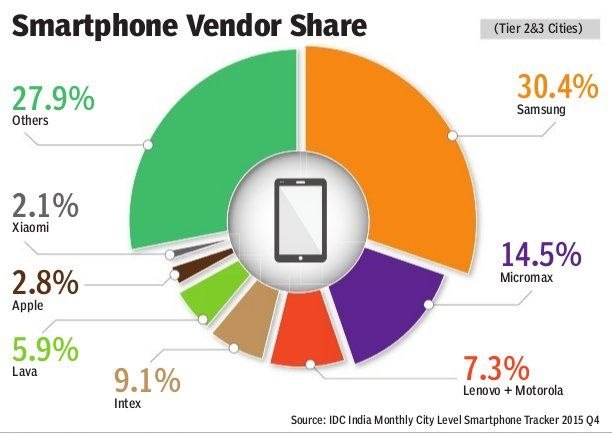
The burgeoning smartphones user base in India, as per a recent report by Counterpoint, has overtaken that of the US, crossing 220 million users by the end of 2015. The top spot is occupied by Samsung, followed by three Indian mobile manufacturing companies, Micromax, Intex and Lava, in that order. A report released earlier this month by International Data Corporation (IDC) bets on tier 2 and tier 3 cities to fuel the growth of the Indian smartphones market in the coming years. The report further states that 21.3% of the Indian smartphones market is spread across 25 major tier 2 and tier 3 cities, with Indian vendors comprising more than two-third of the market.
Jaideep Mehta, managing director, IDC South Asia, credits this to increasing data penetration and reach of e-commerce that is helping a small town consumer be more aware and have evolved demands. “The coming 4G revolution is promising to trigger the next wave of smartphones growth, with 4G enabled devices already overtaking 3G devices as the largest smartphones category,” he says.
The adoption of latest mobile technologies may be happening in the urban centres of the country, but increasingly, tier 2, tier 3 and rural areas are where volumes are expected, over the next few years. This is where Indian mobile manufacturers have an advantage which they seem to have been leveraging successfully so far, with more hits than misses.
The battle, then, for the small town consumer’s wallet is being fought on the ground rather than being led by straightjacket brand communication.
The new normal
The further a vendor moves away from a metro, the more customised his product needs to be. Catering to a non-urban consumer takes away the advantage of dishing out more ‘standardised’ products. The need for having specific features and languages starts differing from that of an urban consumer as you can no longer adapt something that’s more of a global need and downsize it to a tier 2, tier 3 or even a rural market. Accenture’s Masters of Rural Markets: Profitably Selling to India’s Rural Consumers study is indicative of an optimistic approach towards smaller cities with 46% of executive respondents believing that profits can be higher in rural markets. 67% of respondents are planning to rapidly expand in rural markets with 29% being comfortable with the current pace. Only 4% are looking to slow down their rate of rural expansion. What this tells us is that cases can be made about the high operational costs required for such markets but in no way can a company bank on having a dulled approach towards these areas.
The brands with swag
Homegrown brands such as Micromax, Intex, Lava International and Karbonn are some of the top mobile manufacturers that are successful in smaller cities, perhaps, more innovatively than international players in the same market space. The differentiation, then, for players in the affordable mobile phones segment has to go beyond product pricing. Because the value a consumer ascribes to his/her disposable income might be higher even more so in a non-urban area given that such a consumer may not be willing to make purchases for trial purposes.
One such example is Intex, which is leveraging everything from its digital platforms to sporting events to on-ground events to reach its audience. The marketing budget for Intex’s mobile segment is around Rs200 crore for the current fiscal year. Keshav Bansal, director, Intex Technologies, states, “For ATL, Intex has seen a rise in marketing spends (from Rs10 crore in 2007-08 to Rs250 crore in 2015-16) and plans to take it to Rs700 crore in the next two years.”
In terms of customisation, Intex has offerings which provide dual-SIM, long-lasting battery, bigger screens, high-end processors, the Matrabhasha phone that enables communication in 21 Indian regional languages, has a big data saver function and a women safety app, ‘Sashakt’. The company supplements this with over 70 Intex Smart World experience stores spread over 50 cities. Festive occasions are leveraged by the brand for a more intimate and localised connect with the consumer. Intex’s ownership of Gujarat Lions is set to provide it with the platform to have a nationwide reach.
Or take Micromax, which is looking to further category adoption by aiding consumers in their transition from feature phones to smartphones — a painpoint not many international brands extensively cater to. Shubhajit Sen, chief marketing officer, Micromax, sees more upgrade opportunities in a tier 2 or tier 3 town than in a metro.
Micromax brought on Hollywood actor Hugh Jackman as its brand ambassador to fulfil its more global goals. For localised communication needs, the company currently has roped in Kapil Sharma and actor Rana Daggubati. Having them in ads using local languages and broadcasting them on regional channels seems to be helping the brand connect with small towns. The brand currently ranks second in both IDC and Counterpoint reports.
Shashin Devsare, executive director, Karbonn Mobiles, credits the company’s decision to start setting up its distribution at the district and taluka levels, when it comes to what has worked in Karbonn’s favour. He adds that a strong distribution and service network lends credibility to the brand in addition to providing the servicing capability. The company currently covers over 90% of tier 2 and tier 3 districts in the country, Devsare claims. Karbonn Mobiles has used radio extensively in the past with activities such as Karbonn Kamaal Ka Juke Box in Agra. Roadshows too are a means of connecting with audiences. The brand, as part of an initiative, had canter vans travelling across seven cities of Maharashtra and Uttar Pradesh to support the launch of the multimedia devices range. This, in addition to providing products supporting local language functions, tie-ups with online marketplaces and leveraging the festive buying season. Ad spends for the company for 2015-16 are Rs150 crore.
But are these efforts enough?
Elusive top spot
The efforts of the homegrown players seem thorough and focussed on small towns but the number one ranking still eludes them. One of the many things that costs them the spot is the very thing that makes them a popular option – affordability. Navkendar Singh, senior research manager, channels, IDC India, argues that it is more of a perception game. A strong point of such brands indeed is their affordability which gives people a product that is high on specifications but when compared to a global brand or a Chinese brand, the perception of an homegrown brand being of ‘not very high’ quality is still a weak point.
Chinese entrants, both with their pricing and strategy, are putting up a tough fight on shelves for Indian vendors. However, this is where distribution and service network play an important role. “Indian brands are creating point of sale visibility, in shop promoters, regional brand ambassadors and vernacular messaging. But what they are also capable of is providing better service support in comparison to the Chinese brands,” says Singh.
The argument then has moved past which brand can provide the best product at the cheapest price for small towns — even if it seems like it is early days on that front. Consumers are willing to meet manufacturers half way by upping their aspiration quotient, bringing their wants closer to that of a tier 1 city consumer day by day. The disposable income is going up — even if it is happening gradually. The consumer is not shy of spending big, provided a brand can convince them that not only will their phone do what is expected to but that it is ready to evolve beyond expected functions.
“Indian brands are creating point of sale visibility, in shop promoters, regional brand ambassadors and vernacular messaging”
Navkendar Singh, Senior research manager, channels, IDC India
Source: financialexpress.com









































